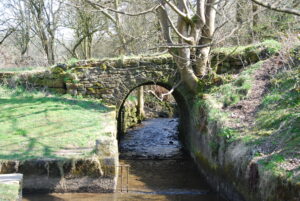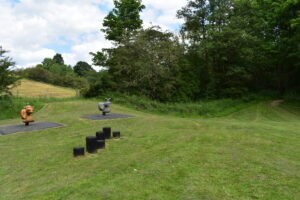We were pleased to welcome Margaret Brown and Wendy Faulkner to talk about Earby’s Corn Mill and its journey from a simple corn mill to its development in the industrial revolution. The earliest mention of Earby is in the Domesday Book.

The Bridge that started it all… behind Earby Youth Hostel. Courtesy of Margaret Brown
Margaret delved back into history to mention that the Romans and Vikings used horizontal mills, the Romans would of course have needed a lot of grain to feed the soldiers in the nearly encampment at Elslack and its highly probable they used nearby Earby’s plentiful water supply. Apparently it takes one and a half hours to grind enough corn by hand for a loaf of bread, doing this for at least 40 Roman soldiers would not have been sustainable, however proof of this earlier mill has not yet been found.
The Danes settled here – Earby is a danish word and of course the Anglo Saxons were around the area, there is a possible AS settlement behind the pub. Our attention was also drawn to the ridge and furrow evident in the Lidar maps, marks left by teams of oxen ploughing the land when grain was grown.

Test Pit Project at Earby. Courtesy of Margaret Brown.
The mill was situated in the back garden of the the old Youth Hostel now owned by the town council. A small group of members from Earby and District Local History Society carried out an excavation, which confirmed a building had existed on the site of the mill, one of the important findings was found by metal detector – Steve’s glasses!
The beck in the village that feeds into the mill race apparently never runs dry which would have enabled the mill to be in constant use, especially when a large mill pond stored the water. A car park exists now on this site.
Documents from 1743 show that work at the mill was dominated by agricultural practices ie production of grain and malt. Some of the names of the people working at that time are still evident in the area today for example, Chadwick, Speak and Atkinson. Outgoings show Poor Law Money, payments for millers wages, dredging a dam and the building of a new kiln – for the malt – £36 14s. 7d. Seven thousand in todays’ money.
As time developed there was marginal living for people in the area and slowly as the wool and cotton industry developed pastoral farming took over from grain production. The mill was converted to cotton spinning.The cotton trade grew apace to the extent that the cotton pickers in places like Barbados could not keep up with demand and the desire to make profits from this burgeoning industry resulted in the Atlantic Slave Trade.

The old mill pond now a playground at Earby. See the camel and the donkey. Courtesy of Margaret Brown.
Social conditions were dire, weavers and spinners were publicly whipped if they were ‘short’. A young brother and sister were severely punished for stealing a bag of flour. The boy probably sent to die on the prison hulks in Portsmouth, the girl to Australia, where they needed females for ‘breeding purposes”. Her relatives are still around today.
Local business men joined together to fund ventures and the mill prospered during the industrial revolution, however after a disastrous fire in 1812 the mill being burnt down never to rise again and the land was eventually sold by the Lister Kay families.
We are hoping that Margaret and Wendy will take us on a walk around the area in the summer. Keep an eye on our website for details.
Banner Image: The stream that fed into the mill race and mill pond. Courtesy of Margaret Brown.